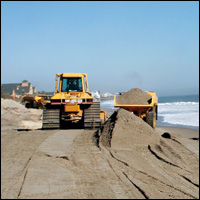 Beach work half done, but bonus near for contractor
Beach work half done, but bonus near for contractor
The contractor who hasn’t finished the barrier island beach replenishment project on time is about to be eligible for an additional $300,000 lump-sum payment from the county -- whether or not residents get all the promised sand on the beach this season.
Amid hasty negotiations to stop a walk-off by the contractor and sand miners, the County Commission not only approved a $3 million increase to the initial contract amount, but also a $300,000 lump-sum payment that would kick in once 269,000 cubic yards of sand had been dumped on the beach.
As of Monday night, Ranger Construction had dumped nearly 253,000 cubic yards of sand on the beach, which is enough material to fill approximately three miles of the 4.4-mile project. But only about 50 percent of the beach and dune have actually been constructed, with only a few days remaining.
The figure of 269,000 cubic yards represents 133 percent of the original contract amount. One grain of sand over that and Ranger Construction can bill for the entire $300,000 for mobilization and demobilization of a third dredge, plus overtime for workers mining sand 24 hours a day on the days when weather and equipment allow them to work.
In exchange, the county nailed down the cost of any additional sand for Phase One or Phase Two of the project at $15.66 per cubic yard. That price is up from the original price of about $14 per cubic yard.
County Public Works Director Chris Mora said he expects Ranger to bill incrementally for actual costs incurred, such as the third dredge operation, which was needed more than one month ago. But, the way the paperwork is worded, according to Director of Management and Budget Jason Brown, the magic number of 269,000 cubic yards triggers the entire lump-sum payment.
“They could, if they bill that way,” Mora said. “If they don’t make the whole template (design), they’re still going to get the whole lump sum.”
Friday could be the county’s last day to work on the beach replenishment. As of press time, county staff was still awaiting word about whether or not an extension of time to complete the first phase of the project would be granted by the Florida Department of Environmental Protection and the U.S. Fish and Wildlife Service. That extension, if granted, would allow construction in the normally off-limits sea turtle nesting season of May 1 through Nov. 1.
Commissioner Gary Wheeler said he inquired about the status of the request for more time and was told by the county’s engineer of record, Coastal Tech, that the chances were good.
“Mike Walther (of Coastal Tech) told me he was optimistic that we could get the extension,” Wheeler said. “He said that he had spoken to them and we had a good shot at getting it.”
In regard to the timing of the lump sum payment, Wheeler said the deal was made and the county would need to stand by it.
“It is what it is,” Wheeler said. “It’s what we agreed to and I wouldn’t try to sidestep it. Hopefully if we get the extension, they’ll be able to finish and get the sand on the beach.”
Should the county not receive an extension, Mora said the piles of sand that have already been piled on the beach will be grated and evened out so there won’t be huge hills of sand randomly placed on the shore.
“We’ll try to get the sand where it’s supposed to go, but worst case, it will just be smoothed out where it is,” Mora said.
The good news is that Wabasso Beach Park and Turtle Trail beach access have re-opened. Should permission be granted to extend work through May 9, construction will continue at Golden Sands and will start at Seagrape Trail, the access point designed to bring sand to the critically eroded areas of Baytree and Marbrisa in the Town of Indian River Shores. Mora said all the beaches will be back open about one week after construction wraps up. Ranger Construction is required to bring the parks and parking lots back to pre-construction state, repairing all parking stops and anything else that may have been damaged. The only work that will continue past the permit period will be the planting of dune-stabilizing vegetation, which will be done with light vehicles.
Over the spring and summer, sea turtle nesting and reproductive rates will be closely watched by regulators, who, based on those statistics, will decide whether or not to issue permits for the second phase of the project. Phase two will begin wherever the first phase left off and will also cover the area from Golden Sands Park north to Treasure Shores Park, including the area of oceanfront Windsor.
Should upland sand prove to be a suitable nesting habitat for the turtles, it will be allowed in the second phase, but the county may need to revert to the tried-and-true pumping of offshore sand if the turtles don’t thrive in the new, trucked-in sand.








